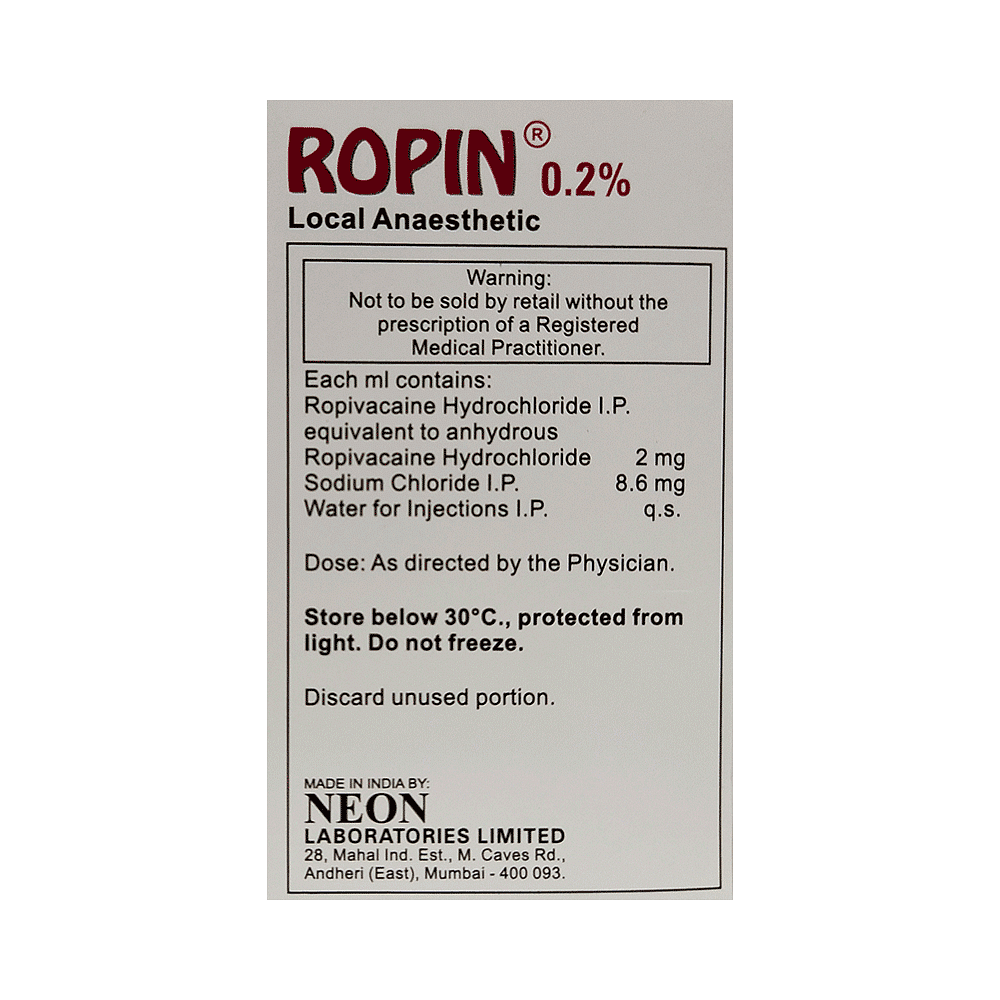


Ropin 0.2% Injection
Manufacturer
Neon Laboratories Ltd
Salt Composition
Ropivacaine (0.2%)
Key Information
Short Description
Ropin 0.2% Injection is a local anesthetic used during minor surgical procedures to anesthetize or numb the surgical area.
Dosage Form
Injection
Introduction
Ropin 0.2% Injection must be administered by healthcare professionals. It blocks the pain signals to reach the brain by temporarily numbing the surgical area and helps to perform a painless procedure. The most common side effects of this medicine include hypotension, nausea, vomiting, slow heart rate, fever, anemia, paresthesia, headache, itching, and back pain. These are usually mild and short-lived. If the numbness or other side effects persist at the injection site, consult your doctor without delay.
Directions for Use
Your doctor or nurse will give you this medicine. Kindly do not self-administer.
Safety Information
Side Effects
hypotension nausea vomiting slow heart rate fever anemia paresthesia headache itching back pain
Alcohol Warning
It is not known whether it is safe to consume alcohol with Ropin 0.2% Injection. Please consult your doctor.
Breastfeeding Warning
Ropin 0.2% Injection is probably safe to use during breastfeeding. Limited human data suggests that the drug does not represent any significant risk to the baby.
Pregnancy Warning
Ropin 0.2% Injection is generally considered safe to use during pregnancy. Animal studies have shown low or no adverse effects to the developing baby; however, there are limited human studies.
How it works
Ropin 0.2% Injection is a local anesthetic. It works by blocking the transmission of pain signals from the nerves to the brain. This helps to decrease the sensation of pain.
Quick Tips
It is given as an injection by the healthcare professional Ropin 0.2% Injection may affect your concentration or make you feel sleepy, so avoid driving or using tools or machines until the next day. Consult your doctor immediately if you experience dizziness, lightheadedness, problem with sight or hearing or numbness around lips, tongue and mouth. Inform your doctor if you are pregnant, planning pregnancy or breastfeeding.
Frequently asked questions
What is Ropin 0.2% Injection used for?
Ropin 0.2% Injection is a local anesthetic used before any surgical or diagnostic procedure to numb the area and reduce discomfort associated with medical instrument insertion, such as needles or catheters.
How is Ropin 0.2% Injection administered? How long does it last?
Ropin 0.2% Injection is supplied as a solution for epidural administration, either by injection or intravenous infusion. The duration of impact on the body varies depending on the administration site and dose, ranging from 3 to 10 hours. Please consult your doctor for detailed information about the specific effects of this medicine.
Is Ropin 0.2% Injection safer than bupivacaine?
Ropin 0.2% Injection is a left isomer of bupivacaine. Compared to bupivacaine, Ropin 0.2% Injection exhibits less toxic effects on the heart and central nervous system. Therefore, it is considered safer than bupivacaine.
What are the side effects of Ropin 0.2% Injection?
Common side effects associated with Ropin 0.2% Injection include paresthesia (tingling or pricking sensation), back pain, irregular heart rate, dizziness, headache, high blood pressure, urinary retention, increased body temperature, cold sensations, and vomiting. These side effects usually subside as the effect of Ropin 0.2% Injection wears off. However, consult your doctor if you experience any worsening of these side effects or have concerns about their severity.
What are the early symptoms of local anesthesia toxicity?
Local anesthetics can affect our nervous system more than any other system in the body. Early symptoms of local anesthesia toxicity include tinnitus (ringing sound in the ears), blurred vision, dizziness, tongue paresthesia (tingling or pricking sensation), and circumoral numbness (numbness around the lips).
Is Ropin 0.2% Injection a steroid?
No, Ropin 0.2% Injection is not a steroid. It belongs to the class of long-acting amides and acts by blocking nerve signals in the injection site to provide temporary numbness. This action limits pain sensation in the treated area.


